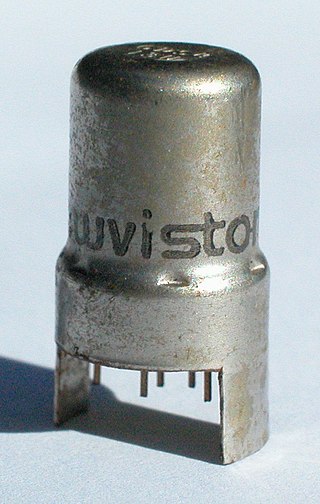
The nuvistor is a type of vacuum tube announced by RCA in 1959. Nuvistors were made to compete with the then-new bipolar junction transistors, and were much smaller than conventional tubes of the day, almost approaching the compactness of early discrete transistor casings. Due to their small size, there was no space to include a vacuum fitting to evacuate the tube; instead, nuvistors were assembled and processed in a vacuum chamber with simple robotic devices. The tube is made entirely of metal with a ceramic base. Triodes and a few tetrodes were made; Nuvistor tetrodes were taller than their triode counterparts.

A microphone, colloquially called a mic, or mike, is a transducer that converts sound into an electrical signal. Microphones are used in many applications such as telephones, hearing aids, public address systems for concert halls and public events, motion picture production, live and recorded audio engineering, sound recording, two-way radios, megaphones, and radio and television broadcasting. They are also used in computers and other electronic devices, such as mobile phones, for recording sounds, speech recognition, VoIP, and other purposes, such as ultrasonic sensors or knock sensors.

Surround sound is a technique for enriching the fidelity and depth of sound reproduction by using multiple audio channels from speakers that surround the listener. Its first application was in movie theaters. Prior to surround sound, theater sound systems commonly had three screen channels of sound that played from three loudspeakers located in front of the audience. Surround sound adds one or more channels from loudspeakers to the side or behind the listener that are able to create the sensation of sound coming from any horizontal direction around the listener.

A ribbon microphone, also known as a ribbon velocity microphone, is a type of microphone that uses a thin aluminum, duraluminum or nanofilm of electrically conductive ribbon placed between the poles of a magnet to produce a voltage by electromagnetic induction. Ribbon microphones are typically bidirectional, meaning that they pick up sounds equally well from either side of the microphone.
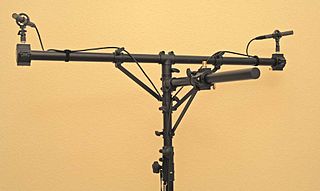
The Decca Tree is a spaced microphone array most commonly used for orchestral recording. It was originally developed as a sort of stereo A–B recording method adding a center fill. The technique was developed in the early 1950s and first commercially used in 1954 by Arthur Haddy, Roy Wallace, and later refined by engineer Kenneth Ernest Wilkinson and his team at Decca Records and its recording studios, to provide a strong stereo image.

A boundary microphone is one or more small omnidirectional or cardioid condenser mic capsule(s) positioned near or flush with a boundary (surface) such as a floor, table, or wall. The capsule(s) are typically mounted in a flat plate or housing. The arrangement provides a directional half-space pickup pattern while delivering a relatively phase-coherent output signal.
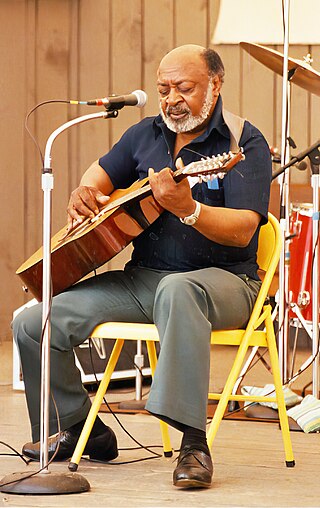
The Shure SM58 is a professional cardioid dynamic microphone, commonly used in live vocal applications. Produced since 1966 by Shure Incorporated, it has built a reputation among musicians for its durability and sound, and is still the industry standard for live vocal performance microphones. The SM58 is the most popular live vocal microphone in the world. It is a development of the SM57 microphone, which is another industry standard for both live and recorded music. In both cases, SM stands for studio microphone.
The Shure SM57 is a low-impedance cardioid dynamic microphone made by Shure Incorporated and commonly used in live sound reinforcement and studio recording. It is one of the best-selling microphones in the world. It is used extensively in amplified music and has been used for speeches by every U.S. president since its introduction in 1965. In 2004, honoring its four decades of "solid, dependable performance", it was inducted into the first-ever TEC Awards TECnology Hall of Fame.

Georg Neumann GmbH is a manufacturer of professional recording microphones. It was founded in by Georg Neumann in 1928 and is based in Berlin, Germany. Their best-known products are condenser microphones for recording, broadcast, and live music production purposes. For several decades Neumann was also a leading manufacturer of cutting lathes for phonograph disks, and even ventured into the field of mixing desks. Today Neumann also manufactures preamplifiers, studio monitors, headphones, and audio interfaces.
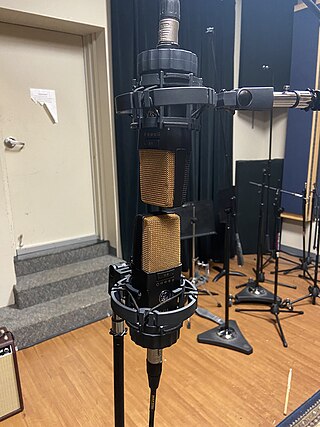
Blumlein pair is a stereo recording technique invented by Alan Blumlein for the creation of recordings that, upon replaying through headphones or loudspeakers, recreate the spatial characteristics of the recorded signal.
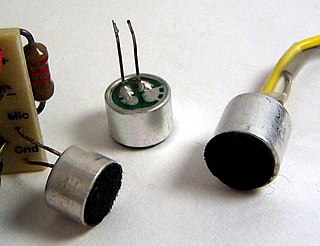
An electret microphone is a type of electrostatic capacitor-based microphone, which eliminates the need for a polarizing power supply by using a permanently charged material.
Schalltechnik Dr.-Ing. Schoeps GmbH, known as Schoeps Mikrofone, is a German manufacturer of professional studio condenser microphones for recording and broadcast. The privately owned company is based in Karlsruhe, south-west Germany, and was founded in 1948.

AKG Acoustics is an acoustics engineering and manufacturing company. It was founded in 1947 by Rudolf Görike and Ernest Plass in Vienna, Austria. It is a part of Harman International Industries, a subsidiary of Samsung Electronics since 2017.

Røde Microphones is an Australian-based audio technology company specializing in the design and manufacturing of microphones, headphones, related accessories, audio interfaces, and audio software. The company has gained recognition as a significant player in various audio categories, catering to consumer, producer, and professional markets. Their product range focuses on applications such as music recording, location sound recordings, broadcast and podcasting, filmmaking, and content creation.
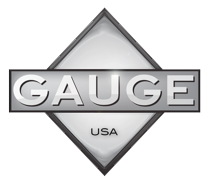
Gauge Precision Instruments is a U.S.-based designer and importer of audio electronics and accessories for professional and consumer markets. The company was founded by Chandler R. Bridges, Jr. and Robert C. Chiarelli in Beverly Hills, CA in 2008. Gauge Precision Instruments' most prevalent product categories are microphones and audio accessories. In January 2012, the company expanded and opened new offices in Tallahassee, Florida. In early 2017, Chiarelli sold his shares to Jeffry Piergeorge.

A valve microphone is a condenser microphone which uses a valve amplifier rather than a transistor circuit.

The Sennheiser MD 421 is a German cardioid dynamic microphone, widely used for speech in broadcasting and for music in live concerts and the recording studio. Introduced in 1960, the internal large-diaphragm transducer element of the MD 421 is still produced unchanged by Sennheiser. The MD 421 is considered a classic, an industry standard. More than 500,000 units have been sold.

The Electro-Voice RE20 is an American professional cardioid dynamic microphone, commonly used in broadcasting applications since 1968. Designed by Electro-Voice using the company's patented Variable-D technology and a large-diaphragm element, it has been described as an industry standard "iconic" microphone for its natural sound and its wide usage in radio, television and recording studios. In 2015, the RE20 was inducted into the TEC Awards Technology Hall of Fame.
Joachim Wetzel was a German radio engineer and microphone maker.

The Neumann U 87 is a poly-directional large-diaphragm condenser microphone. Originally introduced in 1967, a version of the U 87 is still produced by Georg Neumann GmbH. The U 87 became an industry standard recording microphone, a reputation that continues to endure.


















